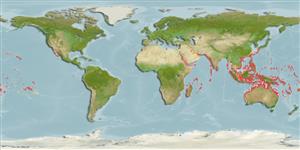Common names from other countries
>
Eupercaria/misc (Various families in series Eupercaria) >
Labridae (Wrasses) > Corinae
Etymology: Cheilio: Greek, chanos, -eos, ous, and chasma, -atos = abyss, mouth opened, inmensity + Latin, muraena = morey eel (Ref. 45335).
More on author: Forsskål.
Environment: milieu / climate zone / depth range / distribution range
Ecología
marino asociado a arrecife; rango de profundidad 1 - 30 m (Ref. 1602), usually 2 - 30 m (Ref. 27115). Tropical; 24°C - 27°C (Ref. 27115); 32°N - 36°S, 24°E - 109°W
Indo-Pacific: Red Sea and East Africa to the Hawaiian and Easter islands, north to southern Japan, south to Lord Howe Island.
Tamaño / Peso / Age
Maturity: Lm ? range ? - ? cm
Max length : 50.0 cm SL macho / no sexado; (Ref. 9823); common length : 35.0 cm TL macho / no sexado; (Ref. 5450)
Short description
Claves de identificación | Morfología | Morfometría
Espinas dorsales (total) : 9; Radios blandos dorsales (total) : 12 - 13; Espinas anales: 3; Radios blandos anales: 11 - 12. Young individuals are usually a mottled brown or green, sometimes with a broad lateral stripe (Ref. 1602). Rare individuals may be uniformly yellow (Ref. 1602). Coloration in this fish is variable: green, brown, orange-brown or yellow, often with narrow, midlateral, broken black stripe which are absent in large males (Ref. 86689). Large males may develop a bright yellow, orange, black, white, or multicolored patch on their sides behind their pectoral fins (Ref. 1602).
Inhabit seagrass beds and algal-covered flats, occasionally in lagoon and seaward reefs to a depth of at least 30 m (Ref. 1602, 41878, 48636). Benthopelagic (Ref. 58302). Usually solitary. Juveniles secretive in seagrasses or attached Sargassum; adults usually in small loose aggregations, but occasionally form large schools to spawn (Ref. 48636). Feed mainly on crustaceans, mollusks, sea urchins (Ref. 37816) and other hard-shelled prey. Oviparous, distinct pairing during breeding (Ref. 205).
Life cycle and mating behavior
Maturities | Reproducción | Spawnings | Egg(s) | Fecundities | Larva
Oviparous, distinct pairing during breeding (Ref. 205).
Randall, J.E., G.R. Allen and R.C. Steene, 1990. Fishes of the Great Barrier Reef and Coral Sea. University of Hawaii Press, Honolulu, Hawaii. 506 p. (Ref. 2334)
IUCN Red List Status (Ref. 130435)
CITES (Ref. 128078)
Not Evaluated
Threat to humans
Reports of ciguatera poisoning (Ref. 130160)
Human uses
Pesquerías: escaso valor comercial; Acuario: Comercial
Herramientas
Special reports
Download XML
Fuentes de Internet
Estimates based on models
Preferred temperature (Ref.
115969): 24.4 - 29, mean 27.7 (based on 1206 cells).
Phylogenetic diversity index (Ref.
82804): PD
50 = 1.0000 [Uniqueness, from 0.5 = low to 2.0 = high].
Bayesian length-weight: a=0.00417 (0.00256 - 0.00679), b=3.09 (2.95 - 3.23), in cm Total Length, based on LWR estimates for this species & (Sub)family-body (Ref.
93245).
Nivel trófico (Ref.
69278): 3.5 ±0.54 se; based on food items.
Resiliencia (Ref.
120179): Bajo, población duplicada en un tiempo mínimo de 4.5-14 años (Preliminary K or Fecundity.).
Fishing Vulnerability (Ref.
59153): Moderate vulnerability (44 of 100).
